 |
| Gustave Courbet, Burial at Ornans, 1851, [Oil on Canvas 315 x 660 cm], Musee D'Orsay, Paris |
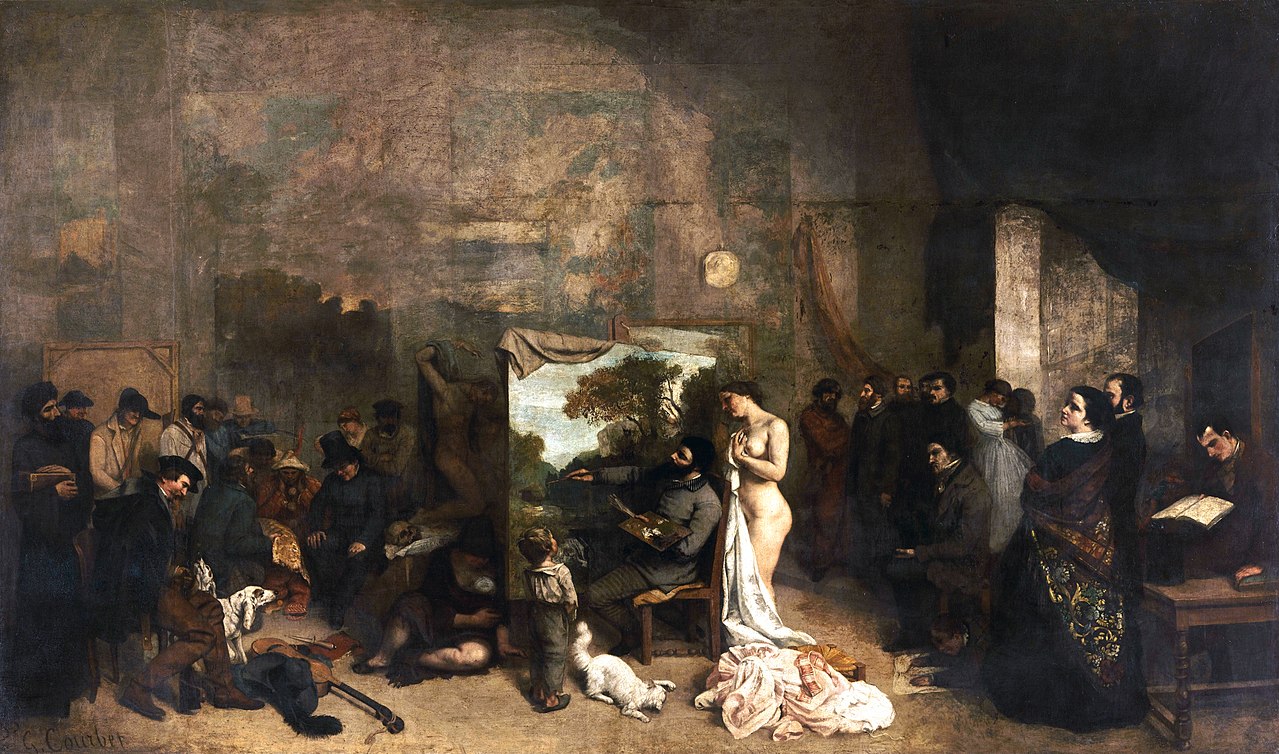 |
| Gustave Courbet, The Artist's Studio, 1854-55, [Oil on Canvas 361 x 598 cm], Musee D'Orsay, Paris |
It was all against the exaggerated emotionalism and drama of the Romantic movement. In opposite, Realism depicted real and typical people with real situations including truth and accuracy in their real life. In the mid 19th Century, Courbet's art caused controversy and a revolution issue. At the State-Sponsored Salon, this was a huge problem because it went against standard academic practice and theory which taught Romanticism. In result to these rules which weren't accepting artists's works including Courbet's, due to statements the state didn't accept with their power, Courbet rebelled with his art.
Realism was a distinct current trend in 20th Century art and usually stuck to artists' desire in exposing more honest and unidealized views of everyday life, thus using their art as a medium to criticize social and political views, which were affecting everybody at the time.
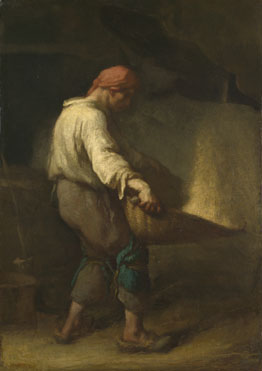 |
| Jean-Francois Millet, The Winnower, 1848, [Oil on Wood 79.5 x 58.5 cm], Musee D'Orsay, Paris |
In works of Millet, "The Winnower" (1848), portrayal to peasant labourers with high rank and recognizable at that time reserved for more important persons was exposed. With 2 world wars, worldwide depression, holocaust and appearance of nuclear weapons, 20th century realist artists had no lack of subjects to point for sure, so modern realism appeared in a wide variety of forms which are still current.
 |
| Gustave Corbet, 1848, Young Ladies of the Village, [Oil on Canvas 194.9 x 261 cm], Metropolitan Museum of Art, New York |
Another example of realism which exposes the aim of realism perfectly, thus to convey a truthful vision of contemporary life emerging from the revolution of 1848 is Courbet's "Young Ladies of the Village" (1852) which exhibited at the Salon of 1852, violating conventional rules of scale and perspective and challenges traditional class distinctions by underlining the close connections between the young women, who represent the emerging rural middle class, and the poor cowherd who accepts their charity.
The main activity of realism was when Courbet's two major works were rejected by the jury of 1855 Exposition Universalle in Paris, and he withdraw his eleven accepted submissions and displayed his paintings privately in his Pavillion du Realisme which was not far from the official international exhibition. He also wrote a Realist Manifesto, echoing the tone of political's manifestos in which he states his goal as an artist "to translate customs, ideas, appearance of my epoch according to my own estimation."
 |
| Honore Daumier, 1864, The First Class Carriage, [Watercolor 20.50 x 30 cm], The Walters Art Museum, Baltimore |
Honore Daumier's "The First Class Carriage" (Walters Art Museum, Baltimore) (1864) offers an idea that there is almost no physical or psychological contact among the 4 well-dressed figures, whereas his "The Third Class Carriage"(1862-64) is tightly packed with an unknown crowd of working class men and women.
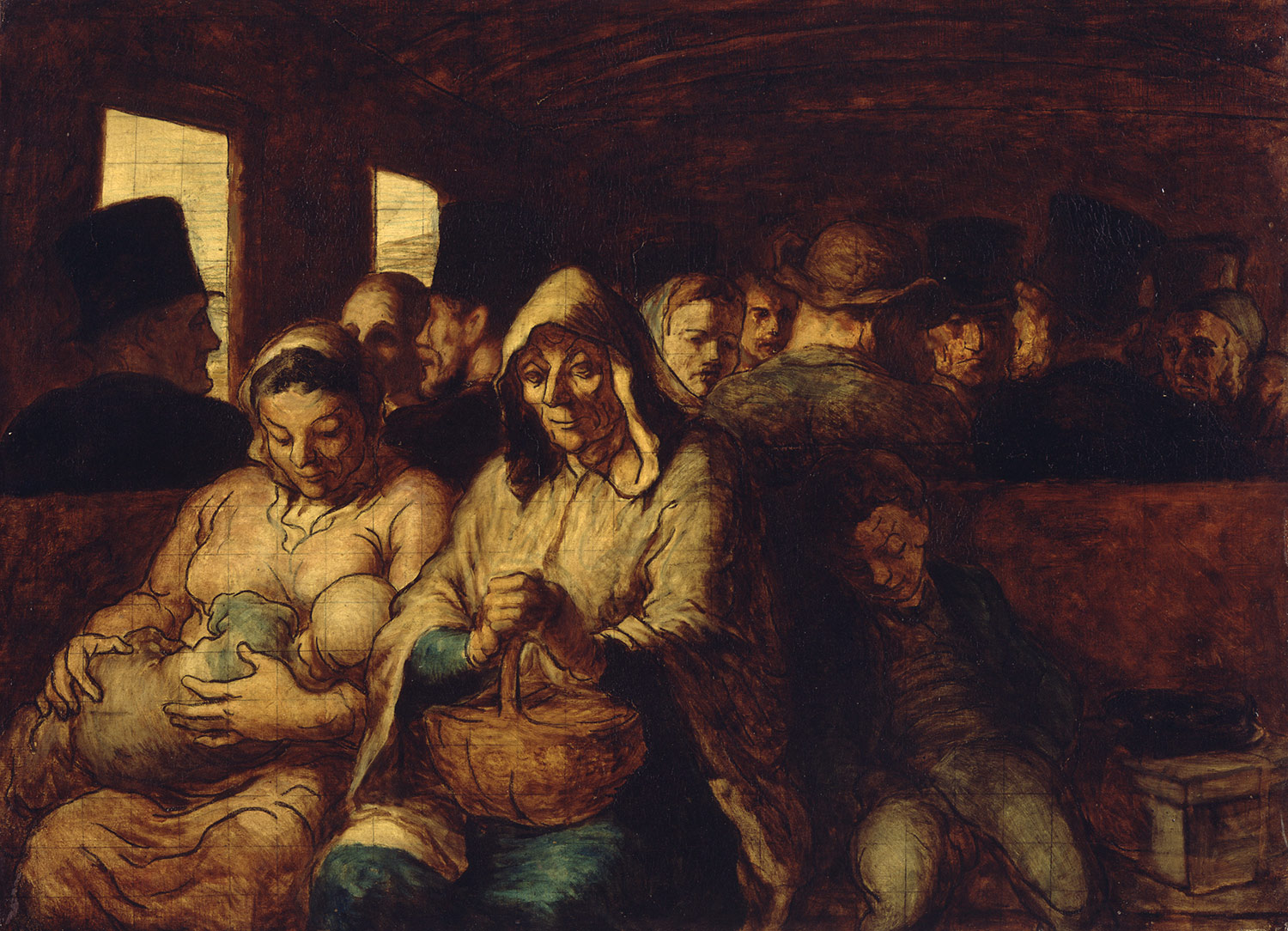 |
| Honore Daumier, 1862-64, The Third Class Carriage, [Oil on Canvas 65.40 x 90.20 cm], Metropolitan Museum of Art, New York |
In the foreground he puts attention to 3 generations of an apparently faithless family, exposing their hard everyday life through the weary poses of the young mother and sleeping boy. Their postures, clothing, and facial features are applied with high detail as those of the first class travelers. In my opinion these two masterpieces are of high importance and level of skill, conveying the true art.
 |
| Gustave Courbet, The Stone Breakers,1849 [Oil on Canvas 165 x 257 cm], Gemaldegalerie, Dresden |
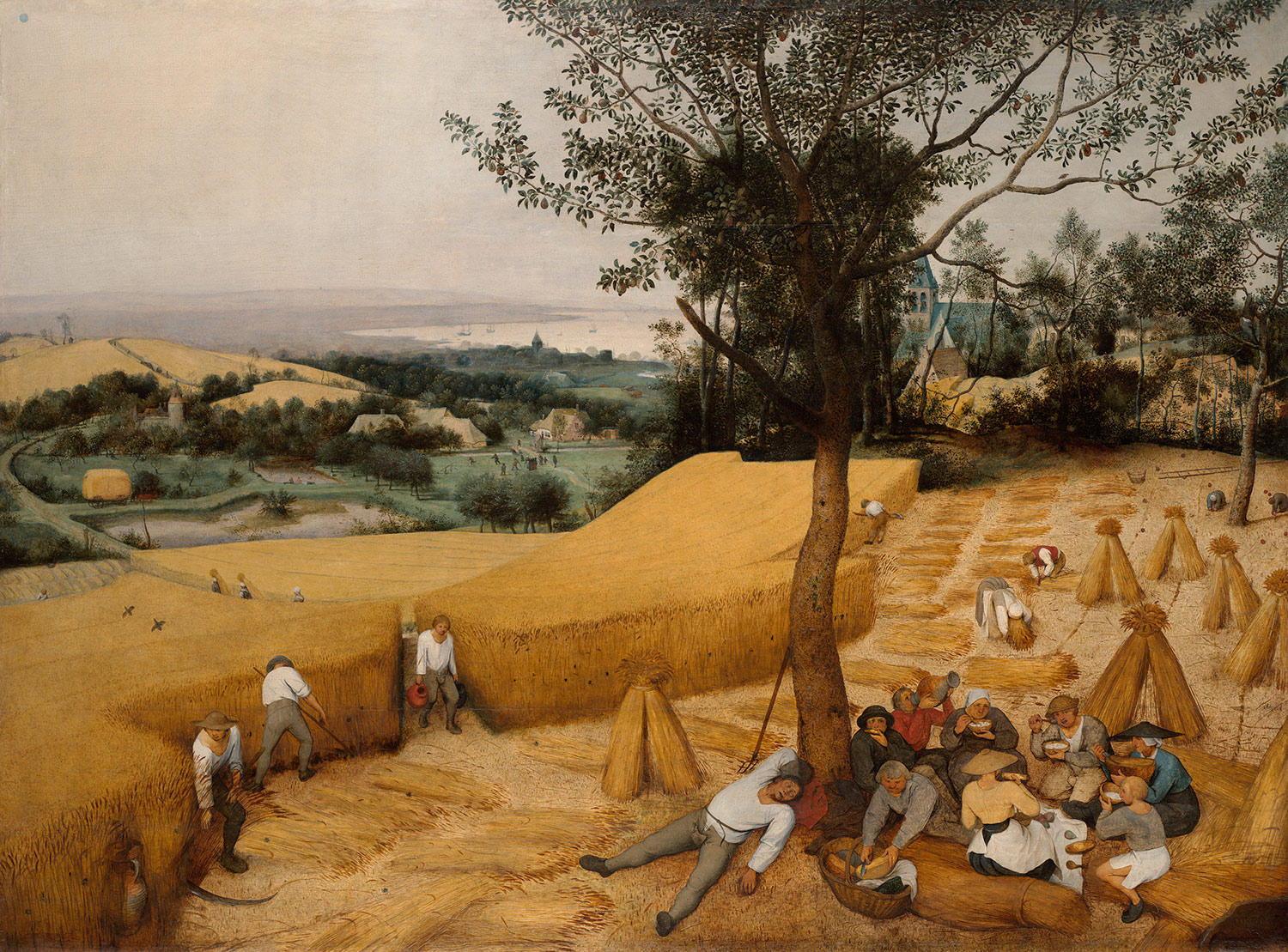 |
| Peter Bruegel, The Harvesters, 1565 [Oil on Wood 119 x 162 cm], Metropolitan Museum Of Art, New York |
Some similarities between works include nature, same use of labor and clothing in Courbet's "The Stone Breakers" 1849, [Oil on Canvas 165 x 257 cm], Gemaldegalerie, Dresden and Peter Bruegel's "The Harvesters " 1565, [Oil on Wood 119 x 162 cm], Metropolitan Museum of Art, New York. Differences include the viewpoint focus of the workers,which Courbet focuses on and gives them importance and realism,also showing the true element of hard work they are producing...On the other hand Bruegel's piece has a more open viewpoint giving a beautiful feeling and mood to it including the use of bright colors with a mass amount of resource with relaxed worker and eating citizens. Shadows are included in Courbet's, which are lacking in Bruegel's vibrant idealized piece, showcasing a picturesque scene that is not actually the case in work at the time.
Genre scenes were expected to be small, pleasant, escapist works to be enjoyed by people living in towns, rather than for a powerful rebellious message. This is what Courbet's aim was and he achieved it, also a reason why his works were being refused in the in the State Salon.
 |
| Jean Francois Millet, The Gleaners, 1857, [Oil on Canvas 83.5 x 110 cm], Musee D'Orsay, Paris |
When this piece was first exhibited, some commentators attacked its implication to the rural poor, which also served as a memory and reminder of the criticized poor serving as a threat to society. Another shocking value was about the twist of the Old Testament's tale of Ruth which showed gleaning in art as a different form and representation, but that wasn't the real truth behind gleaning which Millet exposed well. The Testament shows Ruth characterized as an example of a non-pretentious way to God and not how it is stated in Millet's imagery as a meaning of rural difficulty, which served as the truth.
People seemed to refuse reality as it was, due to the difficulty they didn't want to accept and realize.
In the background we observe a supervisor on a horse, where Millet intentionally put him in, as to give him the least importance, opposite to the workers. This painting shows us how even religious associations are twisted or touched as to depict tough working situations.
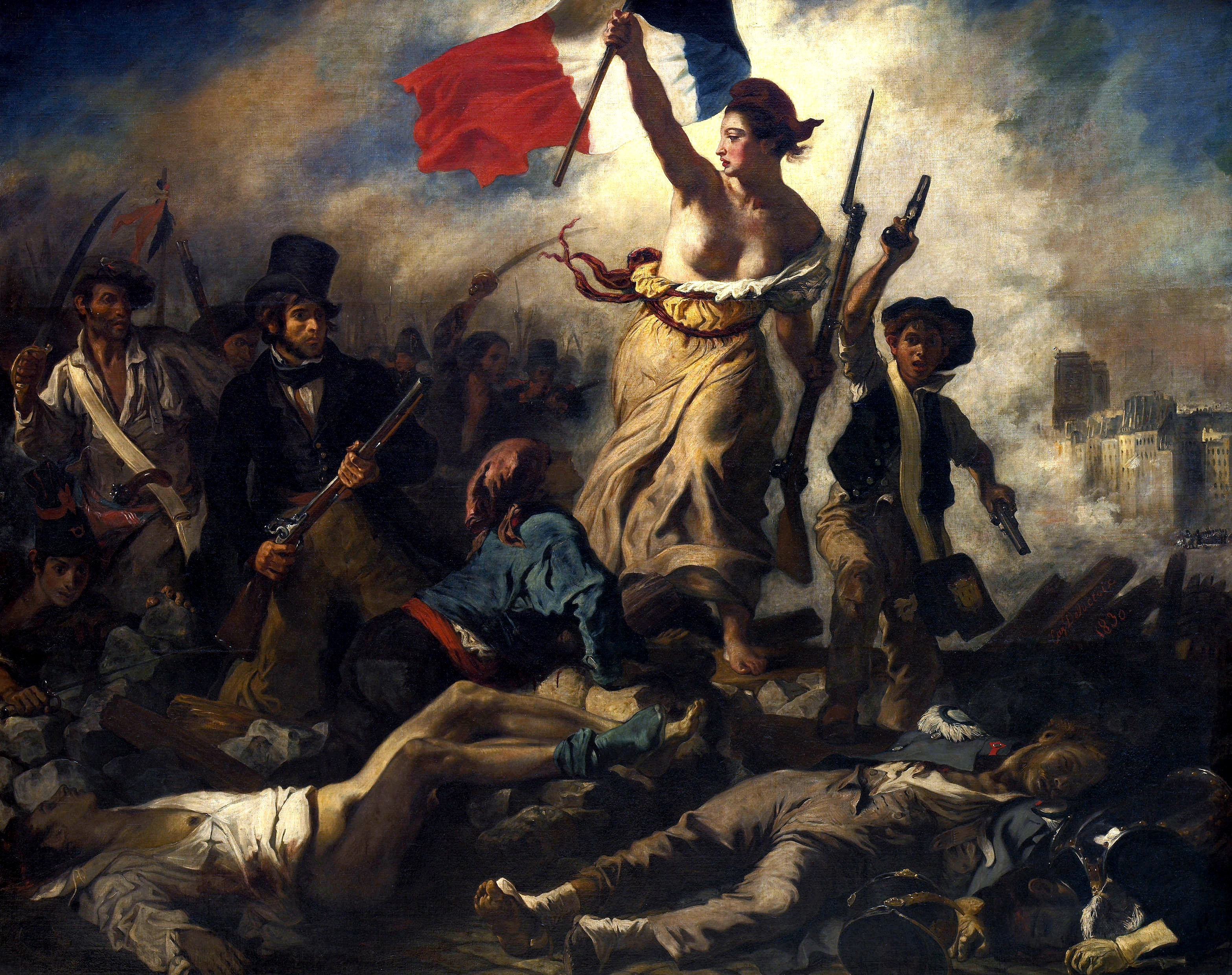 |
| Eugene Delacriox, Liberty Leading The People,1830 [Oil on Canvas 260 x 325 cm], Louvre, Paris |
A patriotic act is visualized especially with a child holding a gun to the air in Eugene's "Liberty Leadin The People" (July 28 1830), Louvre, Paris. An instant disturbance was taking place due to the allegorical woman with a half-draped outfit symbolizing liberty and freedom. This was painted intentionally as women at the time hid freedom and liberty in their everyday lives due to expression views and state rules, thus it represents liberty the way a woman should have had. It was painted the exact day when the people rose and dethroned the Bourbon King. Several classes are included in the painting, symbolizing unity in the revolution, as we see children, workers, soldiers, citizens etc...Eugene is also acting as a National Guard in the left , as he was a member of it.
 |
| Francois Gerard, Cupid and Psyche, 1798, [Oil on Canvas 186 x 132 cm], Louvre, Paris |
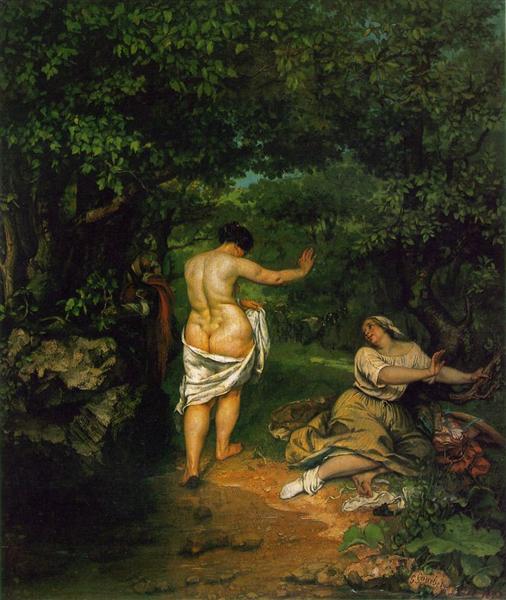 |
| Gustave Courbet, The Bathers, 1853, [Oil on Canvas 227 x 193 cm], Louvre, Paris |
This influence urges me to think with the same concept, where the reality is exposed as it is to trigger minds. Dedication is highly reflected to transmit their concept, and this is something my hands need to apply more on my work ... more hard work, time and dedication.
References :-
Ross Finocchio:: 2015. Nineteenth-Century French Realism | Thematic Essay | Heilbrunn Timeline of Art History | The Metropolitan Museum of Art. [ONLINE] Available at:http://www.metmuseum.org/toah/hd/rlsm/hd_rlsm.htm. [Accessed 12 February 2015].
Encyclopedia of Art Hitory :: 2015.Realism Art Movement: History, Characteristics of Naturalism. [ONLINE] Available at: http://www.visual-arts-cork.com/history-of-art/realism.htm#origins. [Accessed 12 February 2015].
ArtHistory.Net :: 2015. Realism and Art History . [ONLINE] Available at: http://www.arthistory.net/artstyles/realism/realism1.html. [Accessed 15 February 2015].
Encyclopedia Britannica. 2015. realism | art | Encyclopedia Britannica. [ONLINE] Available at:http://www.britannica.com/EBchecked/topic/493052/realism. [Accessed 15 February 2015].
Wikipedia, the free encyclopedia. 2015. Realism (art movement) - Wikipedia, the free encyclopedia. [ONLINE] Available at:http://en.wikipedia.org/wiki/Realism_(art_movement). [Accessed 20 February 2015].
AHRB Centre for Environmental History.:: 2015. Story behind the picture - The Gleaners | Timeline of Waste. [ONLINE] Available at: http://www.st-andrews.ac.uk/~waste/timeline/story-pic1.html. [Accessed 24 February 2015].
Nicolas Pioch :: 2015.WebMuseum: Delacroix, Eug�ne: La Libert� guidant le peuple. [ONLINE] Available at: http://www.ibiblio.org/wm/paint/auth/delacroix/liberte/. [Accessed 24 February 2015]
No comments:
Post a Comment